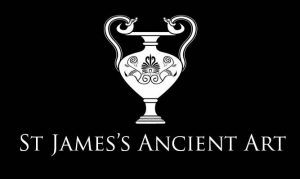Amun was one of the principle deities within the Egyptian pantheon. Worshipped from the Old Kingdom, his importance grew and he was eventually placed as the patron god of Thebes. His national importance was affirmed with the fusion of Amun and the sky-god, Ra, to become Amun-Ra. He was associated by the Ancient Greeks to Zeus. Not seen on scarabs before the 18th Dynasty, the name Amun or Amun-Ra became a popular inscription on amulets in both Egypt and Palestine for the duration of the New Kingdom. These commonly display the name of the god alone and filling their entire field, or accompanied by additional motifs as seen on this piece. The popularity of scarabs dedicated to Amun can be linked with the revival of the deity’s cult after the 2nd Intermediate Period. Scarabs such as this, asking for protection from a specific god were popular in the late New Kingdom Period and Third Intermediate Period.
To discover more about amulets in the Ancient Egyptian world, please visit our relevant post: Amulets in Ancient Egypt.










